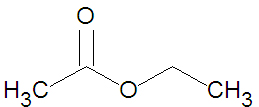Ester
In chemistry, an ester is a chemical compound that contains a carbonyl functionality attached to an alkoxide.
Esters are widely used in the food industry as artificial flavors. Small esters can be used as solvents.
Synthesis
Esters may be formed through a variety of esterification reactions, most typically the condensation reaction of a carboxylic acid and an alcohol[1]. For instance, the ester ethyl acetate (shown in the figure) can be produced from the condensation reaction between acetic acid and ethanol. A second method of ester preparation (alcoholyses) uses an acid chloride instead of a carboxylic acid.
Both methods involve nucleophilic acyl substitution, that is, the replacement of one nucleophile attached to a carbonyl group with a superior nucleophile[1]. In alcoholyses, the leaving nucleophile is a halide rather than a hydroxyl group.
